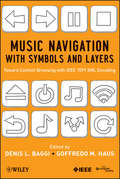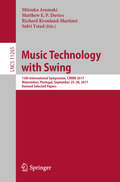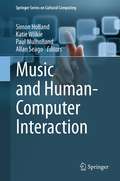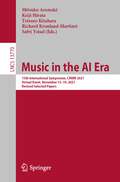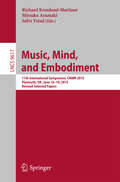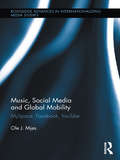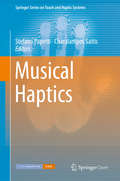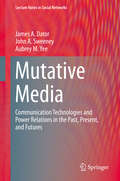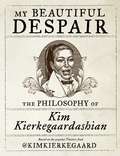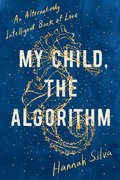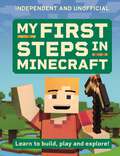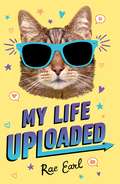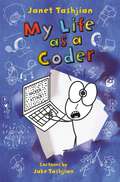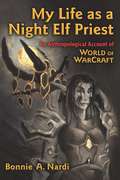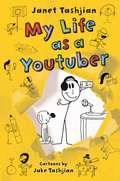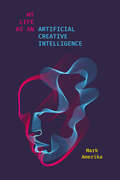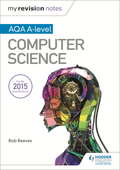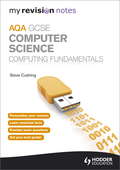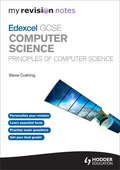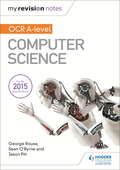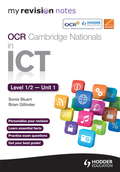- Table View
- List View
Music Navigation with Symbols and Layers
by Goffredo M. Haus Denis L. BaggiMusic is much more than listening to audio encoded in some unreadable binary format. It is, instead, an adventure similar to reading a book and entering its world, complete with a story, plot, sound, images, texts, and plenty of related data with, for instance, historical, scientific, literary, and musicological contents. Navigation of this world, such as that of an opera, a jazz suite and jam session, a symphony, a piece from non-Western culture, is possible thanks to the specifications of new standard IEEE 1599, IEEE Recommended Practice for Defining a Commonly Acceptable Musical Application Using XML, which uses symbols in language XML and music layers to express all its multimedia characteristics. Because of its encompassing features, this standard allows the use of existing audio and video standards, as well as recuperation of material in some old format, the events of which are managed by a single XML file, which is human and machine readable - musical symbols have been read by humans for at least forty centuries.Anyone wanting to realize a computer application using IEEE 1599 -- music and computer science departments, computer generated music research laboratories (e.g. CCRMA at Stanford, CNMAT at Berkeley, and IRCAM in Paris), music library conservationists, music industry frontrunners (Apple, TDK, Yamaha, Sony), etc. -- will need this first book-length explanation of the new standard as a reference.The book will include a manual teaching how to encode music with IEEE 1599 as an appendix, plus a CD-R with a video demonstrating the applications described in the text and actual sample applications that the user can load onto his or her PC and experiment with.
Music Technology with Swing: 13th International Symposium, CMMR 2017, Matosinhos, Portugal, September 25-28, 2017, Revised Selected Papers (Lecture Notes in Computer Science #11265)
by Mitsuko Aramaki Richard Kronland-Martinet Sølvi Ystad Matthew E. DaviesThis book constitutes the refereed proceedings of the 13th International Symposium on Music Technology with Swing, CMMR 2017, held in Matosinhos, Portugal, in September 2017. The 44 full papers presented were selected from 64 submissions. The papers are grouped in eight sections: music information retrieval, automatic recognition, estimation and classification, electronic dance music and rhythm, computational musicology, sound in practice: auditory guidance and feedback in the context of motor learning and motor adaptation, human perception in multimodal context, cooperative music networks and musical HCIs, virtual and augmented reality, research and creation: spaces and modalities.
Music and Human-Computer Interaction
by Simon Holland Katie Wilkie Allan Seago Paul MulhollandThis agenda-setting book presents state of the art research in Music and Human-Computer Interaction (also known as 'Music Interaction'). Music Interaction research is at an exciting and formative stage. Topics discussed include interactive music systems, digital and virtual musical instruments, theories, methodologies and technologies for Music Interaction. Musical activities covered include composition, performance, improvisation, analysis, live coding, and collaborative music making. Innovative approaches to existing musical activities are explored, as well as tools that make new kinds of musical activity possible. Music and Human-Computer Interaction is stimulating reading for professionals and enthusiasts alike: researchers, musicians, interactive music system designers, music software developers, educators, and those seeking deeper involvement in music interaction. It presents the very latest research, discusses fundamental ideas, and identifies key issues and directions for future work.
Music in the AI Era: 15th International Symposium, CMMR 2021, Virtual Event, November 15–19, 2021, Revised Selected Papers (Lecture Notes in Computer Science #13770)
by Mitsuko Aramaki Richard Kronland-Martinet Sølvi Ystad Keiji Hirata Tetsuro KitaharaThis book constitutes the refereed proceedings and revised selected papers from the 15th International Symposium on Music in the AI Era, CMMR 2021, which took place during November 15–19, 2021 as a virtual event. The 24 full papers included in this book were carefully reviewed and selected from 48 submissions. The papers are grouped in thematical sessions on Music technology in the IA era; Interactive systems for music; Music Information Retrieval and Modeling; and Music and Performance Analysis.
Music, Mathematics and Language: The New Horizon of Computational Musicology Opened by Information Science
by Satoshi Tojo Keiji Hirata Masatoshi HamanakaThis book presents a new approach to computational musicology in which music becomes a computational entity based on human cognition, allowing us to calculate music like numbers. Does music have semantics? Can the meaning of music be revealed using symbols and described using language? The authors seek to answer these questions in order to reveal the essence of music. Chapter 1 addresses a very fundamental point, the meaning of music, while referring to semiotics, gestalt, Schenkerian analysis and cognitive reality. Chapter 2 considers why the 12-tone equal temperament came to be prevalent. This chapter serves as an introduction to the mathematical definition of harmony, which concerns the ratios of frequency in tonic waves. Chapter 3, “Music and Language,” explains the fundamentals of grammar theory and the compositionality principle, which states that the semantics of a sentence can be composed in parallel to its syntactic structure. In turn, Chapter 4 explains the most prevalent score notation – the Berklee method, which originated at the Berklee School of Music in Boston – from a different point of view, namely, symbolic computation based on music theory. Chapters 5 and 6 introduce readers to two important theories, the implication-realization model and generative theory of tonal music (GTTM), and explain the essence of these theories, also from a computational standpoint. The authors seek to reinterpret these theories, aiming at their formalization and implementation on a computer. Chapter 7 presents the outcomes of this attempt, describing the framework that the authors have developed, in which music is formalized and becomes computable. Chapters 8 and 9 are devoted to GTTM analyzers and the applications of GTTM. Lastly, Chapter 10 discusses the future of music in connection with computation and artificial intelligence.This book is intended both for general readers who are interested in music, and scientists whose research focuses on music information processing. In order to make the content as accessible as possible, each chapter is self-contained.
Music, Mind, and Embodiment: 11th International Symposium, CMMR 2015, Plymouth, UK, June 16-19, 2015, Revised Selected Papers (Lecture Notes in Computer Science #9617)
by Mitsuko Aramaki Richard Kronland-Martinet Sølvi YstadThis book constitutes the thoroughly refereed post-conference of the 11th International Symposium on Computer Music Modeling and Retrieval, CMMR 2015, held in Plymouth, UK, in June 2015. The 30 full papers presented were carefully reviewed and selected from 126 submissions. This year’s post symposium edition contains peer-reviewed and revised articles centered around the conference theme “Music, Mind, and Embodiment”. It is divided into 6 sections devoted to various sound and technology issues with a particular emphasis on performance, music generation, composition, analysis and information retrieval, as well as relations between sound, motion and gestures and human perception and culture.
Music, Social Media and Global Mobility: MySpace, Facebook, YouTube (Routledge Advances in Internationalizing Media Studies)
by Ole J. MjosThis book is about the relationship between media, communication and globalization, explored through the unique empirical study of electronic music practitioners’ use of the global social media: MySpace, Facebook, YouTube and Twitter. To understand the significance of the emerging nexus between social media and music in a global context, the book explores various aspects of production, distribution and consumption among electronic music practitioners as they engage with global social media, as well as a historical, political and economic exposition of the rise of this global social media environment. Drawing on interview-based research with electronic music artists, DJs, producers and managers, together with the historical portrayal of the emergence of global social media this pioneering study aims to capture a development taking place in music culture within the wider transformations of the media and communications landscape; from analogue to digital, from national to global, and from a largely passive to more active media use. In doing so, it explores the emergence of a media and communications ecology with increased mobility, velocity and uncertainty. The numerous competing, and rapidly growing and fading social media exemplify the vitality and volatility of the transforming global media, communication and cultural landscape. This study suggests that the music practitioner’s relationship with MySpace, Facebook, YouTube and Twitter and the key characteristics of these global social media, alter aspects of our practical and theoretical understandings of the process of media globalization. The book deploys an interdisciplinary approach to media globalization that takes into account and articulates this relationship, and reflects the enduring power equations and wider continuities and changes within the global media and communications sphere.
Musical Haptics (Springer Series on Touch and Haptic Systems)
by Stefano Papetti Charalampos SaitisThis open access book offers an original interdisciplinary overview of the role of haptic feedback in musical interaction. Divided into two parts, part I examines the tactile aspects of music performance and perception, discussing how they affect user experience and performance in terms of usability, functionality and perceived quality of musical instruments. Part II presents engineering, computational, and design approaches and guidelines that have been applied to render and exploit haptic feedback in digital musical interfaces. Musical Haptics introduces an emerging field that brings together engineering, human-computer interaction, applied psychology, musical aesthetics, and music performance. The latter, defined as the complex system of sensory-motor interactions between musicians and their instruments, presents a well-defined framework in which to study basic psychophysical, perceptual, and biomechanical aspects of touch, all of which will inform the design of haptic musical interfaces. Tactile and proprioceptive cues enable embodied interaction and inform sophisticated control strategies that allow skilled musicians to achieve high performance and expressivity. The use of haptic feedback in digital musical interfaces is expected to enhance user experience and performance, improve accessibility for disabled persons, and provide an effective means for musical tuition and guidance.
Mutative Media
by James A. Dator John A. Sweeney Aubrey M. YeeMutative Media is a sweeping examination of how communication technologies have contributed to changes in people's thoughts and actions, and thus in the power structures of societies, in the past, at present, and in four alternative futures. We start by surveying what is generally known about the emergence of human language and speech that has enabled humans to extend their organizing abilities beyond that of other hominids. We then review research on the emergence of signs, symbols, and eventually writing, which led to new ways of thinking, acting, and organizing in scribal societies and vastly extended human influence globally. We consider the impact of the printing press in Europe, the Middle East, China, and Korea that led to various ways of thinking and organizing in modern societies, and conclude our historical survey with a discussion of the emergence and impact of electric and electronic communication technologies from the nineteenth century to the present. After a brief overview of what "futures studies" is and is not, based on our extensive experience in the field, we present four generic alternative futures, and discuss a prototype of a hybrid, mixed-reality game designed to enable players to experience the power and potential of new communication technologies within four very different environments and conditions. We think you will be intrigued by our surprising findings and what they may mean for future generations!
My Beautiful Despair: The Philosophy of Kim Kierkegaardashian
by Kim Kierkegaardashian&“Reflective maxims on life, death, sin, and emptiness, salted with luxury accessories of the Kardashian lifestyle...@KimKierkegaard is dross turned gold, redemption through absurdity in a hundred and forty characters.&” –The New Yorker In &“the ultimate meeting of the sublime with the ridiculous&” (London Evening Standard) My Beautiful Despair blends the existential philosophy of Søren Kierkegaard with the superficial musings of Kim Kardashian West, based on the popular Twitter feed @KimKierkegaard. Kierkegaardashian shares thoughts on fashion, beauty, brunch, and the relentless waves of existential dread that wash over us day after day.A sample of the revelations include: – I have majorly fallen off my workout-eating plan! AND it's summer. But to despair over sin is to sink deeper into it. – Obsessed with protecting your skin, lips, hair & face from the sun? Close the cover of the coffin tight, really tight, and be at peace. – I like my men like I like my coffee: a momentary comfort in the midst of all my suffering. – What is the operation by which a self relates itself to its own self, transparently? Selfie. – What if everything in life were a misunderstanding, what if laughter were really tears? Scared LOL!! – I&’ve been going to bed a little bit earlier each night, to get a taste of death. In an age where the line between news and entertainment is blurrier than ever before, and the difference between a celebrity and the leader of the free world is nil, Kierkegaardashian&’s insights perfectly reflect our absurd, hilarious, and deeply disturbing new era. @KimKierkegaard has been admired, praised, and adored in The New Yorker, The Washington Post, The New York Times, Financial Times, The Economist, New York, Buzzfeed, and more, and has amassed nearly a quarter of a million Twitter followers, including J.K. Rowling and Anna Kendrick. Now in a humorous, illustrated gift book, perfectly suited for our existential times, Kierkegaardashian&’s philosophical insights are juxtaposed for the first time with Dash Shaw&’s brilliant black-and-white illustrations.
My Child, the Algorithm: An Alternatively Intelligent Book of Love
by Hannah Silva"Hannah Silva's My Child, the Algorithm, is one of the best books I read this year. Merging the cozy familiarity of child-rearing with the mysterious tension of AI {...}, she has created a new genre of personal narrative, and a story whose grief, hope and curiosity takes on poetic, spiritual dimensions, even when exploring the most common chambers of the human heart." —Michelle Tea, author, Knocking Myself UpMy Child, the Algorithm tells a story of finding joy after betrayal. Like a male seahorse, Hannah Silva carried a baby made from her partner's egg. But when she gave birth, her partner left, and Hannah found herself navigating life alone with her child.Hannah started playing with a precursor to ChatGPT—wondering what AI could tell us about love. To her surprise, she was moved by the results. The algorithm prompted Hannah to share her explorations of dating, sex, friendship, and life as a queer parent in London. With the help and disruption of two unreliable narrators, a toddler and an algorithm, Hannah deconstructs her story, unraveling everything she has been taught to want, and finds alternative ways of thinking, loving, and parenting today.
My Drunk Kitchen Holidays!: How to Savor and Celebrate the Year: A Cookbook
by Hannah HartNew York Times bestselling author and Food Network star Hannah Hart is back with her biggest book ever: a humorous holiday cookbook celebrating year-round festivities with food, drink, and friends. In a world where everyone is looking for some good news and something to celebrate, Hannah Hart is there with almost fifty ideas, arranged into twelve months of themes and recipes for how to celebrate with family and friends. A collection of recipes, activities, and suggestions about hilarious and joyous ways to celebrate with family, friends, pets, and your entire community, My Drunk Kitchen Holidays! will commemorate holidays from Valentine's Day to Graduation, Pride Month and International Left-Handers’ Day (really!). The book will culminate with the fall holidays that get much deserved attention: recipes for Halloween, Thanksgiving, and a celebration of Hanukkah/Kwanzaa/Christmas that is festive, inclusive, and incredibly hilarious.
My First Book About the Internet
by Sharon CromwellLearning to cybersurf is fun and easy with this beginner's guide. In this book, you'll learn what the Internet is, how it works, how to send E-mail, and all about the World Wide Web. In no time at all, you'll be zipping along the information superhighway!
My First Steps in Minecraft: Learn to Build, Play and Explore!
by Simon BrewEven if you've never played Minecraft - or any other videogame - before, this book will get you making your own amazing block creations in no time. Featuring a simple introduction to how to move and build in Minecraft, the book gives the reader step-by-step guidelines on how to get going. Starting with your very first project, a tiny house, you'll soon be making all kinds of fun and exciting structures. Plus, there's a ton of cool imaginative ideas for making your very own models in Minecraft, letting kids' imagination run riot! With an emphasis on safe play and easy-to-follow text, this is the ideal first Minecraft book for kids who are just starting to play, giving confidence to children and parents alike.
My Life Uploaded (My Life Uploaded)
by Rae EarlFresh, funny, and utterly irresistible, this young adult novel from Rae Earl explores the ups and downs of life online. Hello! Millie Porter here. I’m posting this from a garden shed, because three so-called adults are in the house arguing over whether you can train penguins. You see, I moved in with my dad, granddad, and aunty to escape my mum’s neat freak boyfriend. (He follows me around with a vacuum cleaner, like that’s a normal thing to do. It’s not.)The point is, this reality thing is HARD, so my BFF Lauren and I are taking it online to tell you how to handle it. We are going to make a difference with this vlog. That is, if I can just get Dave the cat’s tail OUT OF MY FACE.Yes, we know it’s usually only übergeeks like Bradley Sanderson who do vlogs. Yes, we know that Instagram queen Erin Breeler will not like it ONE TINY BIT. But Lauren says she’ll be too obsessed with the hot new boy at school to notice us.You get to see me juggling real life, online life, and a cat intent on my destruction as it happens—IRL.This is my life. Uploaded.An Imprint Book "Quite excellent." —Kirkus Reviews
My Life as a Coder (The My Life series #9)
by Janet TashjianMy Life as a Coder is the ninth book in Janet Tashjian's much-loved, diary fiction My Life series starring reluctant reader Derek Fallon, featuring illustrations by Jake Tashjian.Derek Fallon receives an exciting new gift--a laptop! But there's a catch: it has no Wi-Fi so he can't use it for gaming. If he wants to play computer games, he'll have to learn how to code them himself. Another unforgettable adventure awaits in Book 9 of the My Life series, this time involving tech and coding!Christy Ottaviano Books
My Life as a Night Elf Priest
by Bonnie A. NardiWorld of Warcraft rapidly became one of the most popular online world games on the planet, amassing 11.5 million subscribers—officially making it an online community of gamers that had more inhabitants than the state of Ohio and was almost twice as populous as Scotland. It's a massively multiplayer online game, or MMO in gamer jargon, where each person controls a single character inside a virtual world, interacting with other people's characters and computer-controlled monsters, quest-givers, and merchants. In My Life as a Night Elf Priest, Bonnie Nardi, a well-known ethnographer who has published extensively on how theories of what we do intersect with how we adopt and use technology, compiles more than three years of participatory research in Warcraft play and culture in the United States and China into this field study of player behavior and activity. She introduces us to her research strategy and the history, structure, and culture of Warcraft; argues for applying activity theory and theories of aesthetic experience to the study of gaming and play; and educates us on issues of gender, culture, and addiction as part of the play experience. Nardi paints a compelling portrait of what drives online gamers both in this country and in China, where she spent a month studying players in Internet cafes. Bonnie Nardi has given us a fresh look not only at World of Warcraft but at the field of game studies as a whole. One of the first in-depth studies of a game that has become an icon of digital culture, My Life as a Night Elf Priest will capture the interest of both the gamer and the ethnographer.
My Life as a Youtuber (The My Life series #7)
by Janet Tashjian Jake TashjianBook 7 of the much-loved My Life series that has the irrepressible Derek Fallon starting his own Youtube web series!Derek Fallon finally found something to get excited about at school—an extracurricular class on making videos! Together with his friends Carly, Matt, and Umberto, Derek can’t wait to create his own Youtube web series. But he soon realizes Youtube stardom is a lot of work. On top of that, it’s time for his foster monkey Frank to go to monkey college so Derek must scramble to find a reason for Frank to stay with his family—if only a little while longer. Can Derek solve both problems at once? What if Frank became a part of Derek's Youtube videos? Here's another funny and thoughtful novel in the series that centers around most every tween today’s pastime—Youtube! A Christy Ottaviano Book
My Life as an Artificial Creative Intelligence (Sensing Media: Aesthetics, Philosophy, and Cultures of Media)
by Mark AmerikaA series of intellectual provocations that investigate the creative process across the human-nonhuman spectrum. Is it possible that creative artists have more in common with machines than we might think? Employing an improvisational call-and-response writing performance coauthored with an AI text generator, remix artist and scholar Mark Amerika, interrogates how his own "psychic automatism" is itself a nonhuman function strategically designed to reveal the poetic attributes of programmable worlds still unimagined. Through a series of intellectual provocations that investigate the creative process across the human-nonhuman spectrum, Amerika critically reflects on whether creativity itself is, at root, a nonhuman information behavior that emerges from an onto-operational presence experiencing an otherworldly aesthetic sensibility. Amerika engages with his cyberpunk imagination to simultaneously embrace and problematize human-machine collaborations. He draws from jazz performance, beatnik poetry, Buddhist thought, and surrealism to suggest that his own artificial creative intelligence operates as a finely tuned remix engine continuously training itself to build on the history of avant-garde art and writing. Playful and provocative, My Life as an Artificial Creative Intelligence flips the script on contemporary AI research that attempts to build systems that perform more like humans, instead self-reflexively making a very nontraditional argument about AI's impact on society and its relationship to the cosmos.
My Pokémon Baking Book: Delightful Bakes Inspired by the World of Pokémon
by Insight EditionsBake delicious, colorful treats and create lasting memories in the kitchen with your team with these amazing recipes inspired by the world of Pokémon!Explore confections and desserts representing every region of the incredible Pokémon universe. Featuring favorite treats that celebrate beloved characters from the world of Pokémon, My Pokémon Baking Book is the perfect addition to any Pokémon Trainer's kitchen. Great for fans of all ages! 50+ RECIPES: From quick treats to share with friends to dazzling dessert displays perfect for celebrating a Pokémon League victory, My Pokémon Baking Book includes recipes for every occasion. REGIONAL SPECIALTIES: Explore favorite and unique flavors from every currently known region, including the newly discovered region, Paldea! FAVORITE CHARACTERS: Create cookies, cakes, breads, cupcakes, and more with bakery-fresh recipes inspired by Pikachu and friends! DISHES FOR EVERY SKILL LEVEL: With step-by-step instructions and beautiful photographs, My Pokémon Baking Book will teach you how to make iconic foods that bring the vibrant culinary sweets inspired by the world of Pokémon to life. Whether you&’re baking with other Trainers or your family, these easy-to-follow recipes will make you a baking master in no time! COMPLETE YOUR COLLECTION: Looking for more creative fun? My Pokémon Cookbook is available to take you on another Pokémon culinary adventure, while Pokémon Wisdom: A Journal for Embracing Your Inner Trainer provides creative journaling!
My Revision Notes AQA A-Level Computer Science
by Bob ReevesWith My Revision Notes you can: Take control of your revision: plan and focus on the areas where you need to improve your knowledge and understanding with advice, summaries and notes from expert authors Achieve your potential by applying computing terms accurately with the help of definitions and key words on all topicsImprove your exam skills by tackling exam-style and self-testing questions
My Revision Notes AQA GCSE Computer Science Computing Fundamentals
by Steve CushingUnlock your full potential with this revision guide which focuses on the key content and skills you need to know.With My Revision Notes for AQA GCSE Computer Science, which perfectly matches the latest examined elements of the course, you can: Take control of your revision: plan and focus on the areas you need to revise, with advice, summaries and notes from author Steve Cushing Show you fully understand key topics by using specific strategies and theories to add depth to your knowledge of programming and computing issues and processes Apply programming and computing terms accurately with the help of definitions and key words on all topics Improve your skills to tackle specific exam questions such as how to choose appropriate programming languages with the help of self-testing and exam-style questions and answers Get exam ready with last-minute quick quizzes at www.hodderplus.co.uk/myrevisionnotes
My Revision Notes Edexcel GCSE Computer Science
by Steve CushingUnlock your full potential with this revision guide which focuses on the key content and skills you need to know.With My Revision Notes for Edexcel GCSE Computer Science, which perfectly matches the latest examined elements of the course, you can:- Take control of your revision: plan and focus on the areas you need to revise, with advice, summaries and notes from author Steve Cushing- Show you fully understand key topics by using specific strategies and theories to add depth to your knowledge of programming and computing issues and processes- Apply programming and computing terms accurately with the help of definitions and key words on all topics- Improve your skills to tackle specific exam questions such as how to choose appropriate programming languages with the help of self-testing and exam-style questions and answers
My Revision Notes OCR A level Computer Science
by George Rouse Sean O'Byrne Jason PittWith My Revision Notes you can: Take control of your revision: plan and focus on the areas where you need to improve your knowledge and understanding with advice, summaries and notes from expert authors Achieve your potential by applying computing terms accurately with the help of definitions and key words on all topicsImprove your exam skills by tackling exam-style and self-testing questions
My Revision Notes OCR Cambridge Nationals in ICT Levels 1 / 2 Unit 1 Understanding Computer Systems
by Sonia Stuart Brian GillinderUnlock your full potential with this revision guide which focuses on the key content and skills you need to know.
